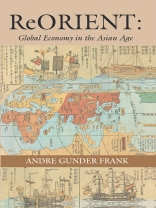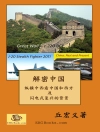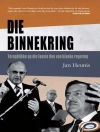Andre Gunder Frank asks us to Re Orient our views away from Eurocentrism—to see the rise of the West as a mere blip in what was, and is again becoming, an Asia-centered world. In a bold challenge to received historiography and social theory he turns on its head the world according to Marx, Weber, and other theorists, including Polanyi, Rostow, Braudel, and Wallerstein. Frank explains the Rise of the West in world economic and demographic terms that relate it in a single historical sweep to the decline of the East around 1800. European states, he says, used the silver extracted from the American colonies to buy entry into an expanding Asian market that already flourished in the global economy. Resorting to import substitution and export promotion in the world market, they became Newly Industrializing Economies and tipped the global economic balance to the West. That is precisely what East Asia is doing today, Frank points out, to recover its traditional dominance. As a result, the ‘center’ of the world economy is once again moving to the ‘Middle Kingdom’ of China. Anyone interested in Asia, in world systems and world economic and social history, in international relations, and in comparative area studies, will have to take into account Frank’s exciting reassessment of our global economic past and future.
สารบัญ
PREFACE
I
Introduction to Real World History vs. Eurocentric Social Theory
Holistic Methodology and Objectives
Globalism, not Eurocentrism
Smith, Marx, and Weber
Contemporary Eurocentrism and Its Critics
Economic Historians
Limitations of Recent Social Theory
Outline of a Global Economic Perspective
Anticipating and Confronting Resistance and Obstacles
2
The Global Trade Carousel 1400-1800
An Introduction to the World Economy
Thirteenth- and Fourteenth-Century Antecedents
The Columbian Exchange and Its Consequences
Some Neglected Features in the World Economy
World Division of Labor and Balances of Trade
Mapping the Global Economy
The Americas
Mrica
Europe
West Asia
The Ottomans
Safavid Persia
India and the Indian Ocean
North India
Gujarat and Malabar
Coromandel
Bengal
Southeast Asia
Archipellago and Islands
Mainland
Japan
China
Population, Production, and Trade
China in the World Economy
Central Asia
Russia and the Baltics
Summary of a Sinocentric World Economy
3
Money Went Around the World and Made the World Go Round
World Money: Its Production and Exchange
Micro- and Macro-Attractions in the Global Casino
Dealing and Playing in the Global Casino
The Numbers Game
Silver
Gold
Credit
How Did the Winners Use Their Money?
The Hoarding Thesis
Inflation or Production in the Quantity Theory of Money
Money Expanded the Frontiers of Settlement and Production
In India
In China
Elsewhere in Asia
4
The Global Economy: Comparisons and Relations
Quantities: Population, Production, Productivity, Income, and Trade
Population, Production, and Income
Productivity and Competitiveness
World Trade 1400-1800
Qualities: Science and Technology
Eurocentrism Regarding Science and Technology in Asia
Guns
Ships
Printing
Textiles
Metallurgy, Coal, and Power
Transport
World Technological Development
Mechanisms: Economic and Financial Institutions
Comparing and Relating Asian and European Institutions
Global Institutional Relations
In India
In China
5
Horizontally Integrative Macrohistory
Simultaneity Is No Coincidence
Doing Horizontally Integrative Macrohistory
Demographic; Structural Analysis
A ‘Seventeenth-Century Crisis’?
The 1640 Silver Crises
Kondratieff Analysis
The 1762-1790 Kondratieff’B’ Phase: Crisis and Recessions
A More Horizontally Integrative Macrohistory?
6
Why Did the West Win (Temporarily)?
Is There a Long-Cycle Roller Coaster?
The Decline of the East Preceded the Rise of the West
The Decline in India
The Decline Elsewhere in Asia
How Did the West Rise?
Climbing Up on Asian Shoulders
Supply and Demand for Technological Change
Supplies and Sources of Capital
A Global Economic Demographic Explanation
A Demographic Economic Model
A High-Level Equilibrium Trap?
The Evidence: 1500-1750
The 1750 Inflection
Challenging and Reformulating the Explanation
The Resulting Transformations in India, China, Europe, and the World
In India
ln China
In Western Europe
The Rest of the World
Past Conclusions and Future Implications
7
Historiographic Conclusions and Theoretical Implications
Historiographic Conclusions: The Eurocentric
Emperor Has No Clothes
The Asiatic Mode of Production
European Exceptionalism
A European World-System or a Global Economy?
1500: Continuity or Break?
Capitalism?
Hegemony?
The Rise of the West and the Industrial Revolution
Empty Categories and Procrustean Beds
Theoretical Implications: Through the Global Looking Glass
Holism vs. Partialism
Commonality/Similarity vs. Specificity/Differences 3
Continuity vs. Discontinuities
Horiwntal Integration vs. Vertical Separation
Cycles vs. Linearity
Agency vs. Structure
Europe in the World Economic Nutshell
Jihad vs. Mc World in the Anarchy of the Clash of Civilizations?
REFERENCES
INDEX
เกี่ยวกับผู้แต่ง
Andre Gunder Frank (1929-2005), of the University of Toronto, published more than thirty books. He coedited, with Barry Gills, World System: Five Hundred Years or Five Thousand? (1996).












